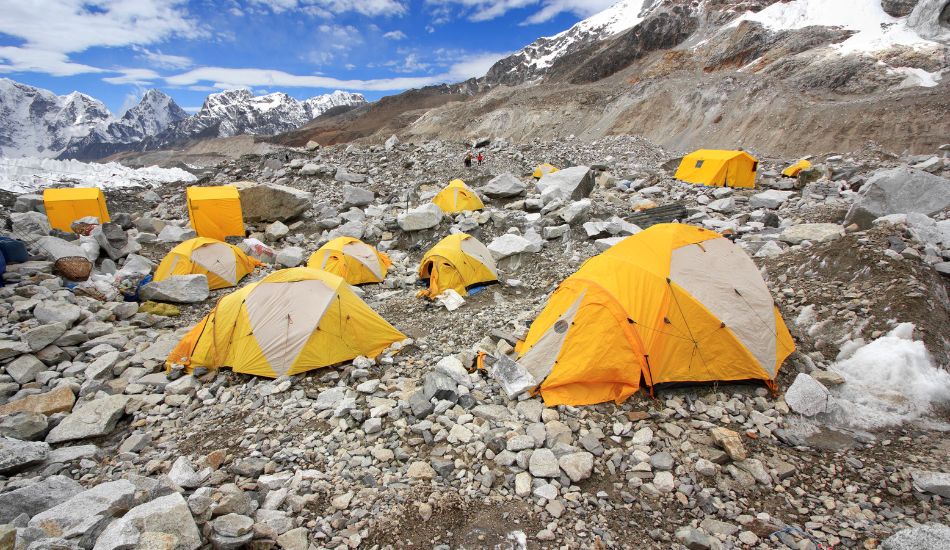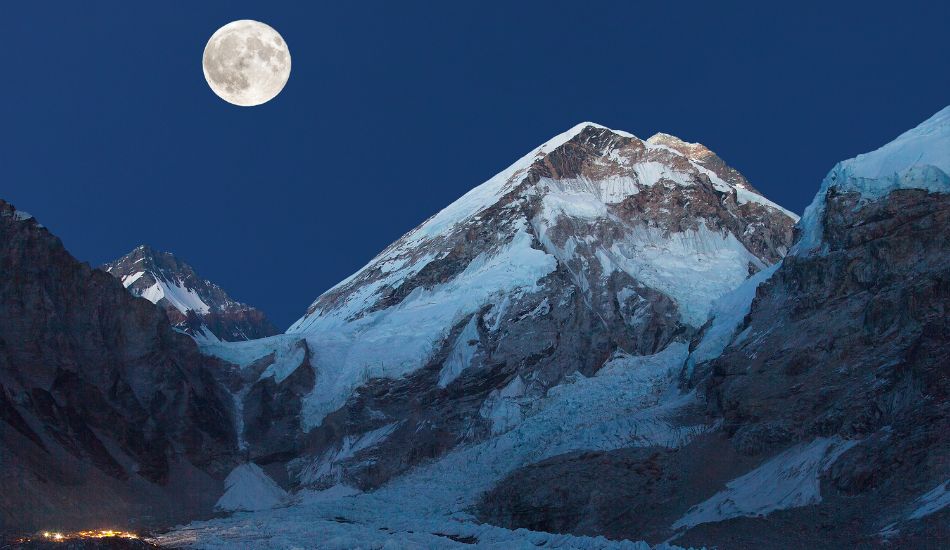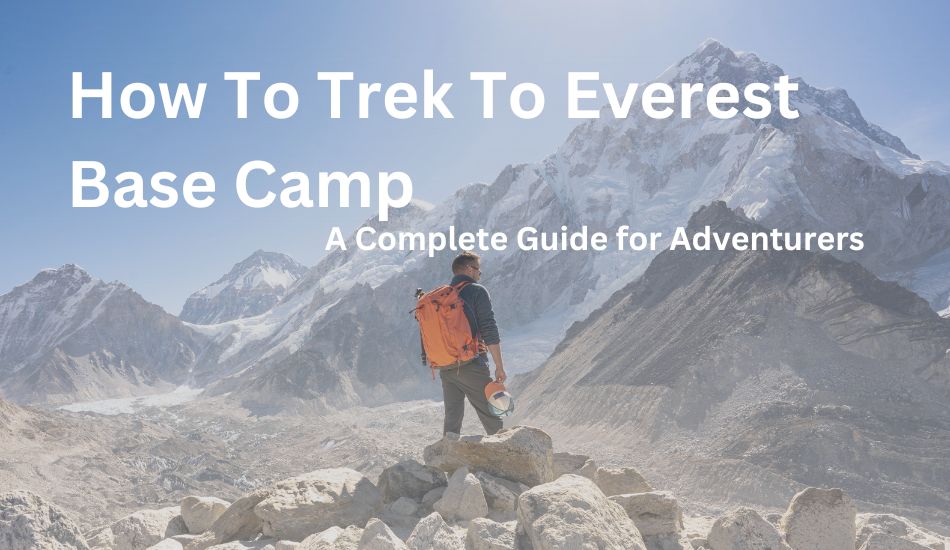How to Trek to Everest Base Camp: A Complete Guide for Adventurers
Trek to Everest Base Camp is a lifetime adventure that embraces breathtaking views, thrilling challenges, and attachment to nature. With the Everest base camp height of 5,364 meters, you'll be surrounded by towering peaks with endless glaciers, feeling a sense of unparalleled achievement. The journey takes one through serene valleys, traditional Sherpa villages, and rugged historical trails.
Each step traces the route of legendary climbers who dared to confront the highest mountain in the world. Of course, the scenery is there, but reconnecting with one's adventurous spirit is more important in this trek. It is an experience that leaves an imprint on your soul.
A Quick Overview of the Trekking Journey

This 12—to 14-day adventure usually takes you through beautiful Sherpa villages, thick rhododendron forests, and rugged mountain landscapes. Trekkers experience everything from acclimatization challenges to heartwarming cultural exchanges along the way. The Everest Base Camp trek itinerary is designed to balance adventure with enough rest and adaptation time to prepare you for the altitude.
Who This Guide Is For
First-time trekkers
Adventure enthusiasts
Budget-conscious travelers
Nature lovers
Safety-conscious trekkers
Anyone seeking a life-changing adventure
Best Time to Trek: Seasons and Weather Insights

Spring (March to May)
This is one of the best times to trek to EBC. During the day, temperatures remain between 10°C to 15°C, while during nights, -5°C to -10°C is normal. This season is well-recognized for having clear skies with colored rhododendron flowers that attract good weather.
During this time, the trails are more accessible, and mountain views are great because of fantastic visibility. However, this is also the peak season to trek, so you should expect a lot of people on the trial.
Autumn (September to November)
Autumn is also the best time to trek to EBC. In this season, daytime temperatures are usually between 8°C and 12°C; at night, the temperature can fall between -5°C and -10°C. The weather is generally stable, with very little rain, so any day has clear skies with panoramic views of mountains.
The weather is crisp and cool, and the visibility is fantastic, ideal for photography. The crowds are slightly smaller compared to spring, yet it is still a busy time to go on a trek.
Winter (December to February)
Winter in the Everest region brings cold and challenging conditions, with daytime temperatures ranging from 5°C to 8°C and nighttime temperatures dropping significantly to -10°C to -15°C. While the trails are quieter and the mountain views are crisp and clear, winter trekking requires careful preparation. The paths can be icy, and higher altitudes may experience severe cold, making it less comfortable for many trekkers.
For those willing to brave the cold, winter offers an incredibly peaceful, isolated trekking experience with fewer trekkers on the trails.
Monsoon (June to August)
Due to extensive rainfall, the monsoon season is the least favored time of the year to trek to EBC. The day temperature ranges from 15°C to 18°C, while the night temperature cools down to 5°C to 8°C. As a result, the trails will be slippery due to the rains, and the clouds obscure the magnificent mountain views.
The land will truly be green during this season, with lush landscapes being very beautiful but with wet conditions, including leeches on the lower trails. The visibility could be better, and many trekkers seek to avoid this season for better conditions and views.
Fitness and Training Tips: How to Get Trek-Ready
Aerobic exercises like running, cycling, or swimming will improve your endurance.
Squats, lunges, and step-ups strengthen the legs and core.
By practicing with a weighted backpack, you can simulate the trek weight carried in the hike.
Inclined training or on stairs builds strength for steep ascents.
Regular stretching helps with flexibility and reduces injury.
Mental stamina can also be worked on through challenging treks or endurance activities.
Train at higher altitudes or on a stair climber to acclimate yourself to thinner air.
Take time to rest and recover so your muscles can heal and strengthen.
Recommendation Read: How To Train For Everest Base Camp Trek
[H2] Essential Gear Checklist for a Comfortable Trek

- Trekking Boots
- Clothing Layers
- Down Jacket
- Trekking Poles
- Sleeping Bag
- Backpack
- Water Bottles / Hydration System
- Headlamp
- First-Aid Kit
- Sunscreen & Sunglasses
- Water Purification Tablets
- Camera
- Snacks
- Personal Identification
- Portable Charger / Power Bank
- Toiletries
Learn more about on our blog, What To Pack For Everest Base Camp Trek
Permits and Paperwork You’ll Need
TIMS (Trekkers' Information Management System) Card: This is compulsory for all trekkers entering restricted trekking areas. It allows the government to keep track of trekkers for safety and security reasons. You get it at the Nepal Tourism Board or through an authorized trekking agency. Also you can read the blog how to obtain Nepal Trekking Permit for more details.
Sagarmatha National Park Permit: This permit is needed to enter Sagarmatha National Park, where EBC is located. Revenue from this permit helps in nature conservation within the park and other forms of conservation. You can obtain this permit at the park entrance or in Kathmandu.
Khumbu Pasang Lhamu Rural Municipality Permit: Trekkers must have this permit when crossing the Khumbu region, including parts of Everest. It helps the local communities build infrastructure within the area and is obtainable at the local municipality office in Lukla or Phakding.
Passport (with a valid visa for Nepal): A valid passport is necessary for entering Nepal, and a tourist visa is compulsory for all international travelers. You should carry a photocopy of your passport and your visa while trekking.
Travel Insurance (covering trekking and evacuation): You will want this in your name in case of an emergency, such as medical reasons or evacuation. Make sure the high-altitude trekking and the possibility of helicopter evacuation are covered.
Flight Tickets (to and from Kathmandu): These are required for entry into Nepal and onward travel to Lukla to commence the trek. They must be booked in advance and are part of your travel documentation.
Emergency Contact Information: Always carry local emergency services and your embassy and travel insurance contacts. This is very helpful in case of accidents or unexpected situations on a trek.
Essential Trekking Preparations For Nepal
Day-by-Day Breakdown of the Trek
Day 1: Arrival in Lukla & Trek to Phakding [2,610 meters I 3-4 hours]
It is a short flight from Kathmandu to Lukla and then one trek to Phakding, a nice village by the Dudh Koshi River. Today's trek is comparatively short, which means it will give enough time for acclimatization and getting used to the terrain. Most of the trail today is downhill, keeping tiredness away on the first day.
Day 2: Phakding to Namche Bazaar [3,440 meters I 6-7 hours]
This is one of the more difficult days because it goes upwards to Namche Bazaar, considered the Sherpa capital of the Khumbu region. Along the route to Namche, several suspension bridges over the Dudh Koshi River, an immaculate forest, and villages are crossed. Many places to stay and ample shopping areas for trekkers make Namche, the biggest settlement on this trek, an ideal spot for acclimatization.
Day 3: Acclimatization Day at Namche Bazaar [3,440 meters I 4-5 hours]
You will rest today to prepare for altitude gain. Nearby Everest View Hotel offers great panoramic views of Mount Everest, Lhotse, and Ama Dablam. As your body gets acclimatized for further trekking, you can explore the local markets and monasteries.
Day 4: Namche Bazaar to Tengboche [3,860 meters I 5-6 hours]
Trek through pine and rhododendron forests toward Tengboche. This day's views of Everest, Lhotse, and Ama Dablam are incredibly beautiful. The famous Tengboche Monastery lies here, and it's a nice place to enjoy the surroundings of the Himalayas and the spiritual atmosphere in the region.
Day 5: Tengboche to Dingboche [4,410 meters I 5-6 hours]
This day takes you through higher altitudes, and the change in the landscape will strike you as the forest gives way to more rugged terrain. Dingboche is renowned for its marvelous panorama of surrounding peaks and its tranquility, making it an ideal stop for acclimatization.
Day 6: Acclimatization Day at Dingboche [4,410 meters I 3-4 hours]
Spend the day relaxing and acclimatizing to the altitude. You can hike to Nagarjun Hill for spectacular views of Imja Tse, Makalu, and other towering peaks. This will help your body get used to the thin air and prepare for more demanding days.
Day 7: Dingboche to Lobuche [4,940 meters I 5-6 hours]
Trek past memorials to fallen climbers as you make your way to Lobuche, a popular stop on the journey to EBC. The landscape becomes much more barren, and the altitude starts to take its toll, but the views of the surrounding mountains are nothing short of spectacular.
Day 8: Lobuche to Gorak Shep & Everest Base Camp [5,364 meters I 7-8 hours]
Day: This is the big day! Start the trek to Gorak Shep, where you'll drop heavy gear. The final leg now takes you up to EBC, where views of the Khumbu Icefall greet you, along with towering mountains. Very few feelings can match the triumph of emotions that overwhelm upon reaching Base Camp.
Day 9: Gorak Shep to Kala Patthar & Return to Pheriche [5,545 meters I 7-8 hours]
Get up early for Kala Patthar, one of the best viewpoints for panoramic views of Mt. Everest. From there, it is downwards to Pheriche, at a lower altitude, for rest and recovery after the hard journey to Base Camp.
Day 10: Pheriche to Namche Bazaar [3,440 meters I 6-7 hours]
Trek back to Namche Bazaar through beautiful rhododendron forest and picturesque villages. The route from here is mostly downhill, but the drop can still put a lot of pressure on the knees, so it's better to go at your own pace.
Day 11: Namche Bazaar to Lukla [2,860 meters I 6-7 hours]
On the last day of the trek, go down to Lukla. Much of this is downhill, but the perverse undulations can be tiring. Reach Lukla and join other trekkers in celebrating your successful completion before flying back to Kathmandu.
Day 12: Fly from Lukla to Kathmandu [1,400 meters]
Board an early morning flight from Lukla to Kathmandu, and thus, come to an end with your EBC adventure with lifetime memories of the unforgettable Himalayas.
Everest Base Camp Trekking Routes
Must-See Highlights Along the Way
Mount Everest Viewpoint (from Namche Bazaar): Take your breath on your first breathtaking views of Mt. Everest and other giants such as Lhotse and Ama Dablam from a vantage point in Namche Bazaar.
Tengboche Monastery: A serene and holy destination, Tengboche Monastery is among the Khumbu region's oldest and most significant monasteries. Situated on the slope, it offers great views of the surrounding peaks, including that of Everest.
Everest Base Camp: The iconic EBC is the ultimate highlight. From 5,364 meters, one sees breathtaking views of the surrounding peaks, glaciers, and the Khumbu Icefall.
Kala Patthar: A necessary detour, this panoramic view of Mt. Everest Summit at 5,545 meters similarly offers a stunning sunrise view over the world's tallest peak.
Dingboche & Imja Tse: Dingboche is renowned for its beautiful alpine landscape, which is good for acclimatization. En route, it offers fantastic views of Imja Tse.
Lobuche Memorials of Climbers: A sad yet touching stop, the memorials are dedicated to brave climbers who lost their lives while attempting to summit Mount Everest.
The Khumbu Icefall: Your trek to EBC takes you along the Khumbu Icefall, a huge glacier that any Everest climber must pass through. It's a breathtaking view filled with crevasses and towering ice formations.
Sherpa Villages and Culture: Small villages, like Phakding and Namche Bazaar, are steeped in Sherpa culture. You'll find vibrant monasteries, prayer flags, and stupas, making it a truly immersive cultural experience.
Experiencing the Culture and Landscape
Local Villages: Connecting with the Sherpa Community
Your EBC trek would take you through several villages of the Sherpas, each with its own culture and local way of life. The Sherpas are strong, friendly, and bonded to the mountains. You can stop and talk with the people in these villages as you visit them, learn about their culture and traditions, and taste their warm hospitality.
These villages also host significant cultural landmarks such as monasteries, prayer flags, and stupas, which add to the trek's spiritual importance.
Featured Trip: Everest Three High Passes Trek
Food and Accommodation on the Trail
Teahouses or lodges offer food and accommodation along the EBC trek. Meals are very basic and nutritious, with dal bhat, momos, noodles, and rice dishes aimed at keeping trekkers going all day. Accommodations provided are shared rooms, and the bedding is simple. While teahouses are normally warm, it is highly recommended to bring a good sleeping bag for use on cold nights.
Hot drinks include tea and coffee to boost your energy level. A few showers and restrooms are provided, although usually for an extra fee, and reservations beforehand are required to ensure availability, particularly during peak seasons.
Wildlife and Scenic Views to Look Out For
- Snow Leopard
- Himalayan Tahr
- Musk Deer
- Himalayan Monal
- Yaks
- Mount Everest
- Ama Dablam
- Lhotse and Nuptse
- Dudh Koshi River
- Prayer Flags and Monasteries
Challenges and How to Overcome Them
Dealing with Altitude and Fatigue
Altitude Sickness:
Altitude sickness is an issue that your body has to face once it cannot adapt to the lesser availability of oxygen at higher altitudes. Symptoms include headaches, dizziness, nausea, and shortness of breath. It usually starts above 2,500 meters and may worsen if not treated accordingly. The best way to avoid altitude sickness is to ascend very slowly and give time for acclimatization.
Fatigue:
Fatigue during long treks is common, especially as altitudes increase. Physical exertion, insufficient rest, and the body's adjustment to thinner air are generally responsible for fatigue. Symptoms of fatigue may include a general lack of energy, an inability to concentrate well, and/or a slower pace. Most importantly, make sure to stay hydrated, eat well, and take regular breaks along the way.
Staying Safe and Healthy During the Trek
- Pack a first-aid kit with many bandages, pain relievers, and medications for altitude sickness.
- Stay hydrated; drink much water to avoid dehydration, increasing fatigue, and worsening altitude sickness.
- Eat well-balanced meals to maintain energy levels and help your body cope with the physical demands.
- Rest often, and don't overexert yourself; your body needs time to recuperate.
- Heed your guide and local Sherpas for suggestions about your safety and health concerns.
- Adequate rest every night can help your body recover and heighten the acclimatization phase.
- Avoid alcohol and smoking because they will worsen your body's ability to adjust to a high attitude.
- Look after your gear and be conscious of accidents and injuries when trekking.
Final Thoughts
Everest Base Camp trekking with Dolpo Caravan Treks will be an unforgettable experience of great views, exploring Sherpa culture, and overcoming new challenges. Everest Base Camp trek cost depends on factors like season and duration. However, the adventure involved in this trek is well worth it. With proper preparation and the help of guides from Dolpo Caravan Treks, you will surely be safe and enjoy the trek to the fullest.
Whether you are a newcomer or a seasoned adventurer, this trek will surely be etched in your memory for life. Get set going on the most memorable trip!
FAQs
Is Everest Base Camp dangerous?
The trek to Everest Base Camp is not dangerous per se but has its fair share of risks: altitude sickness, weather oscillations, and exhaustion from exercising on a steep incline. These risks can be reduced by prior preparation, acclimatization, and the presence of a guide. Generally speaking, most trekkers with average fitness and caution should go through the trek safely.
How long does it take to trek to EBC?
Due to the acclimatization of altitudes, EBC Trekking usually takes 12 to 14 days, depending on route variation and rest days. It includes time to get used to the altitude and sightseeing around. Some trekkers may choose an itinerary that can be longer or shorter based on preference and physical aptitude.
What is the best time to trek to EBC?
The best time to trek is during the spring, from March to May, and autumn, from September to November, because this is when the weather is best. During these seasons, you will see clear skies, stable temperatures, and the best visibility of the mountains. Avoid trekking during the monsoon season, between June and August, because of heavy rain and not-so-easy trail conditions.
Should I be an experienced trekker for the EBC trek?
No, you do not necessarily need to be an experienced trekker, but you must be in good physical condition and ready for long days of walking. It's manageable at high altitudes, but training before going and taking it easy will help you acclimatize appropriately. A guide will also make it easier and far safer for beginners.
What is the cost of the EBC trek?
The cost of a trek to EBC may vary from $1,200 to $2,500, depending on what the services cover: flights, guides, accommodation, and permits. Normally, this would cover everything from the trek to meals and basic accommodations, but this may vary with different packages. Finding a good agency that provides the best value for money is best.


Leave Your Comment